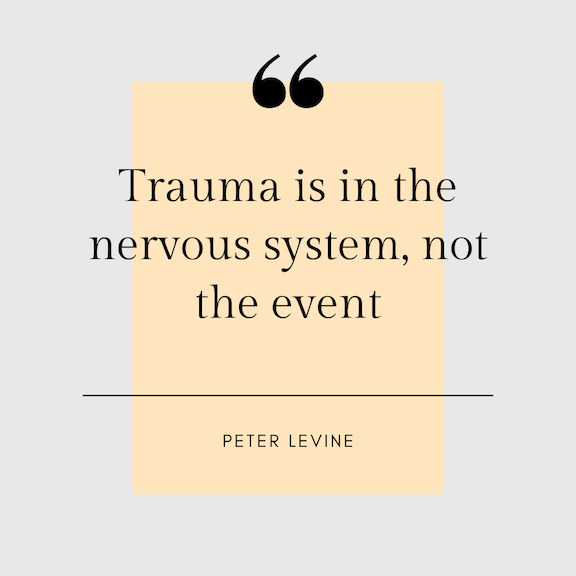Redefining Trauma
When you hear the word “trauma,” what comes to mind? A near-death experience? A natural disaster? While these situations could be considered traumatic, how we define trauma is dependent on who experiences the trauma. Recently, the psychiatric and counseling fields have begun to view trauma from a different perspective. According to The National Council for Behavioral Health, 70% of adults in the U.S. have experienced at least one traumatic event. Furthermore, according to the Centers for Disease Control and Prevention (CDC), 61% of adults in the U.S. have experienced at least one Adverse Childhood Experience (ACE), which is a traumatic event occurring prior to age 18.
Were you surprised by these statistics? If you were, I’m not surprised by your surprise. Many people I encounter think of trauma as a huge catastrophic event; they may not even realize they’ve endured trauma at some point in their lifetime. What complicates things even further is that trauma can often be the absence of something (e.g., neglect, poverty). In the following sections, I’ll describe a comprehensive, new way of thinking of trauma, discuss how trauma impacts the body, provide some evidence-backed treatment for unresolved trauma, and briefly touch on the intersection between trauma and faith.
What is Trauma?
July’s Counseling Today’ cover story centered on trauma. In an excellent piece, Bethany Bray summarized the thoughts of clinicians around the U.S. on trauma, including its definition, causes, impacts, and treatments. You can read the full article here.
So, what is trauma exactly? As I mentioned earlier, what’s considered traumatic varies from person to person. Based on what we know, trauma can be defined as:
An experience or series of experiences that is subjectively distressing and exceeds an individual’s capacity to cope. Trauma can have lasting somatic and psychological consequences if left unprocessed. Trauma can be acute (i.e., a single incident), chronic (i.e., repeated exposure), or complex (i.e., multiple varied experiences).
Examples of traumatic experiences
Trauma and The Body
To understand trauma’s lasting impacts, it’s important to know how the brain and body function when encountered with a traumatic event. Before we get to the process, let’s define some important components of the brain.
In the book The Body Keeps the Score, Bessel Van Der Kolk, M.D. describes the Triune (Three-part) Brain:
The reptilian brain is the oldest part of the brain and is responsible for all functions necessary to survive (e.g., eating, sleeping, pooping, and peeing).
The mammalian brain, or limbic system, sits right above the reptilian brain and is responsible for housing emotions, monitoring danger and threat, judging what’s pleasurable or scary, and deciding what’s important or not for survival.
The neocortex is the top layer of the brain and the youngest part of the brain. It is mostly comprised of the frontal lobes, which are responsible for higher cognitive functions such as language, abstract thought, planning, reflecting, and imagining.
Source: Medium
Other relevant parts of the brain regarding trauma include the following:
The thalamus, located in the limbic system, takes in sensory input and sends the information to the amygdala and the frontal lobes. Van Der Kolk identifies the thalamus as the “cook” in the brain. What’s important to note is that the information reaches the amygdala much quicker than it reaches the frontal lobes.
The amygdala, located in the limbic system identifies whether something is relevant for survival. It does this with the help of the hippocampus, which is responsible for relating new input to past experiences. Van Der Kolk identifies the amygdala as the “smoke detector” in the brain. What’s important to note is that the amygdala could decide whether incoming input is a threat before we are even consciously aware of it.
The medial prefrontal cortex, located within the frontal lobes, allows us to take a bird’s eye view of what’s occurring and make decisions accordingly. Van Der Kolk identifies it as the “watchtower” in the brain.
In addition to brain structures and functions, the autonomic nervous system plays an important role in trauma. The autonomic nervous system is comprised of two systems: the sympathetic nervous system, which is analogous to the body’s accelerator, and the parasympathetic, which is analogous to the body’s brake. When we are threatened in some way, our survival instincts kick in, which activates our sympathetic nervous system. This is where we often hear about the fight, flight, or freeze response. In an ideal scenario, a threat is present, our bodies prepare for survival, our bodies take some type of action, the threat is not longer present, and our parasympathetic nervous system kicks in to guide our bodies back to its normal state and releases excess energy. However, what if we can’t get away? What if we can’t take any survival action? This pent-up energy and hormones the body is carrying havd nowhere to go. Therefore, the body and nervous system remain stuck. Furthermore, because trauma overwhelms us, parts of our brain that are not necessary for survival (i.e., the neocortex) shut off.
So, given that a lot is happening internally as we experience something traumatic, what are some possible long-lasting effects?
Aches or tension felt in certain areas of the body
Emotional disorders such as anxiety and/or depression
Nervous system arousal upon experiencing anything familiar to the original trauma
Fragmented memories of the traumatic experience. This one is huge! Unfortunately, people who are not trauma-informed become frustrated with a person when they are unable to recall specific details of the experience. This is completely normal, given that the part of the brain that is charge of encoding a complete memory shuts off.
Inability to feel that the trauma is over. Many people who have incomplete experiences of trauma feel like the trauma is still happening. In these cases, it’s important to help the person orient themselves to the present while they are processing the past. Many trauma treatments utilize this simultaneous processing to help clients “complete” the traumatic experience.
Evidenced-Based Trauma Treatments
Being trauma informed as a practitioner is becoming a huge focus of most mental health professions. Previously, trauma was considered a specialty and clinicians would pick and choose whether they wanted to work with trauma. As we are starting to realize that most people have been impacted by trauma in some way, picking and choosing to be trauma-informed doesn’t make sense anymore. Therefore, it’s important that any mental health clinician you see is trauma informed.
A few of the main treatments for trauma include the following:
Eye Movement Desensitization and Reprocessing (EMDR)
Trauma-Focused Cognitive Behavioral Therapy (TF-CBT)
Somatic Experiencing (SE)
Eye Movement Desensitization and Reprocessing (EMDR)
As stated on the EMDR website, EMDR is a psychotherapy that enables people to heal from the symptoms and emotional distress that are the result of disturbing life experiences. In a nutshell, a client undergoing EMDR treatment will choose a target memory to process and simultaneously focus on an external stimulus. This external stimulus is typically lateral eye movements that are completed by tracking the therapist’s finger. Distressing or negative feelings are desensitized during the process and new associations and adaptive memories are created. Many outcome studies have been completed on EMDR and results show that it is considered an effective treatment for trauma.
Trauma-Focused Cognitive Behavioral Therapy (TF-CBT)
According to the TF-CBT website, is an evidence-based treatment for children and adolescents impacted by trauma and their parents or caregivers. TF-CBT is a structured, short-term treatment model that effectively improves a range of trauma-related symptoms with the child/adolescent and caregiver. TF-CBT addresses post-traumatic stress disorder (PTSD) symptoms, depression, anxiety, cognitive, and behavioral problems. Additionally, it helps parents cope with their own distress about the child’s traumatic experience and improve their parenting and interactions with their child. Similar to EMDR, many outcome studies have been completed on TF-CBT and it is considered an evidence-based treatment for children and adolescents.
Somatic Experiencing (SE)
SE is a body-oriented therapeutic model applied in multiple professions and professional settings—psychotherapy, medicine, coaching, teaching, and physical therapy. Somatic approaches focus on how the body influences thoughts, emotions, and behaviors; help people become aware of body sensations and procedural memories; target underlying dysregulation in the nervous system that causes/maintains symptoms; help create a greater control over debilitating symptoms and unconscious dynamics; and rely on body awareness & physiological
Regulation. EMDR was the first somatic approach recognized as an evidence-based treatment for trauma. SE targets the nervous system and helps clients identify and move through their bodily “stuck” points.
Trauma and Faith
In a paper published by Yaqeen Institute, Najwa Awad and Sarah Sultan provide a comprehensive overview of trauma and its impact from various perspectives. Specifically, they touch on how trauma can have both negative and positive impacts on faith. It’s not uncommon for people to question their faith or develop doubts after going through something traumatic. An example of a question they may ask is, “Why would God do this to me?” The following verse of the Qur’an alludes to the possibility of experiencing difficult times: “Do the people think that they will be left to say: We believe, and they will not be tried? But we have certainly tried those before them, and Allah will surely make evident those who are truthful, and He will surely make evident the liars” (Qur’an, 29:2-3). We’ve heard time and time again that God tests us. However, this concept can be hard to grapple with amid our pain and suffering. Awad and Sultan suggest utilize faith and our relationship with God as a source of stability and growth during good times and bad. This strong spiritual relationship can serve as protection against future adversity. In a previous blog post, I wrote about how God can be an attachment figure you can turn to in times of distress. Similarly, you can use your faith as a protective factor in helping you heal from trauma.
Concluding Remarks
The unfortunate reality is that most of us have or will have experienced a traumatic event or series of traumatic events at some point during our lives. Understanding this, however, can help us having more compassion for ourselves and for others. I hope this post has provided some insight into what exactly trauma is, how it impacts our brains and bodies, and how to handle it from a faith perspective. As always, if you are struggling with trauma or anything mental health related, please seek help from a licensed professional.




